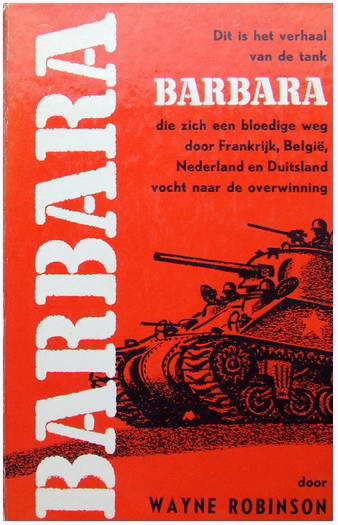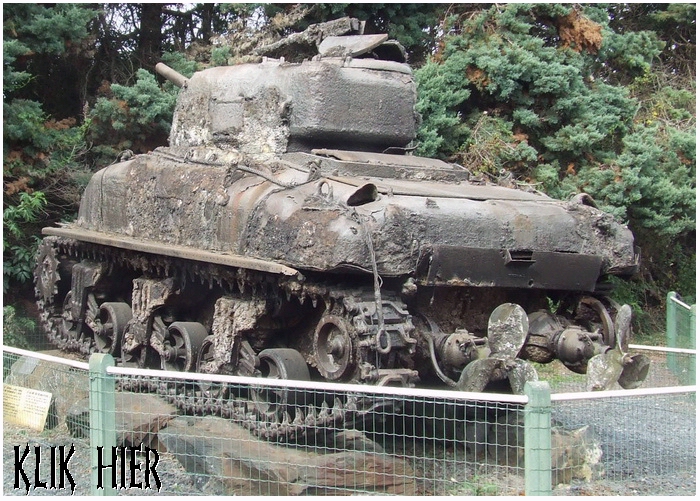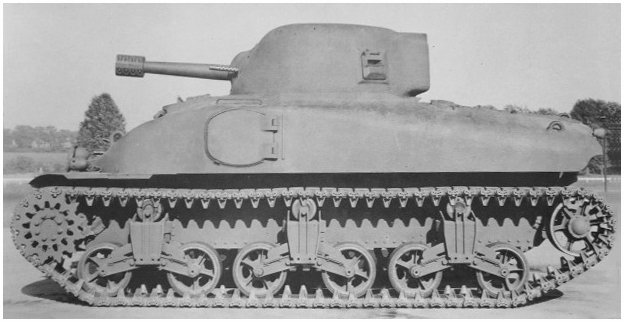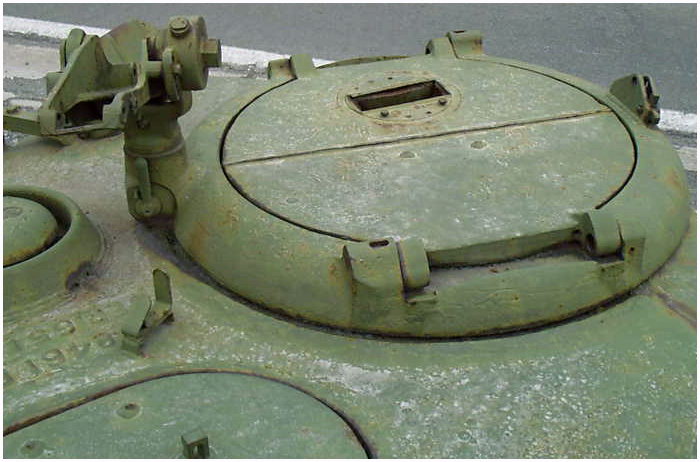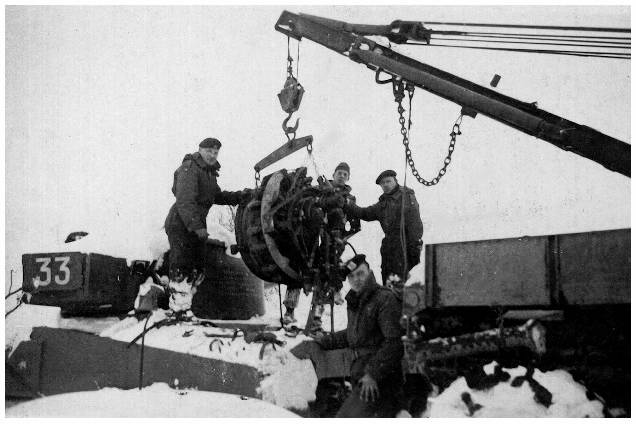|
It all started with the finding of a red covered book. Fat
white lettering on it's back read; 'BARBARA'. With naughty thoughts
I pulled it out of the bookcase. It was written by Wayne Robinson and
it was far from 'juicy'. The story was about a tank that wore the
title of the book. Naughty thoughts disappeared and claustrophobic
horror took its place. The main caracter in the book was an M4
Sherman tank and its crew. In DD configuration it came ashore at
Omaha Beach, Normandy and fought a bloody battle all the way into
Germany. With an atlas beside me, I read the book in one stroke of a
breath. The fascination for the M4 Medium Tank was born.
The book I have is a Dutch translation from 1965 and has some flaws,... or so I thought.
One of these 'flaws' deserved some research and got an own page: 'DD-tanks on Omaha Beach'
In April 1941 five proposals for a middleweight tank were brought forward to the
American army. With the designation ‘Medium Tank T6’, it was obvious what is heritage was,
it had the same chassis as the M2A1 and M3, and mechanics.
New was a turtle shell hull, doors at the side of the hull
and a central placed one pieced turret with a 75mm cannon and a
coaxial .30 machinegun. The front of the turret had a removable frontplate to
accomodate other weapons than just the 75mm. As with M3 there were two .30
fixed machineguns placed in the hull (beside the one for the assistant driver).
In May 1941 the Ordnance Committee gives the order that a wooden mock-up and a prototype must
be built. The first prototype, built at Aberdeen, had a cast hull. The second so called pilot
was constructed bij Rock Island Arsenal. This one had a welded hull but no turret. In September
1941 the T6 was presented at Aberdeen to the Armored Forces and the Ordnance Department. It had
a 75mm M2 cannon. For balance reasons some counterweights were placed at the end of the barrel.
In the turret were on both sides pistolports. During the first inspection changes were made.
The two sponson doors on the side of the hull were eliminated. Just as the high cupola for the
commander. Later on an order was given that near the commanders cupola a
.50 machingun had to be installed and that the front machinegun was placed in a ball for
better movement. The name, M4 Medium Tank, was in October 1941 standardized
when testing was successfull. Beside the designation in a letter/number, the name Sherman
was adopted, as suggested by the Brittish army, after General William T. Sherman, who fought
with the Nothern troops during the American Civil War.
By early 1942 the first new tanks came of the production line.
One of the first changes was deleting the doors on the side of the
hull. An extra hatch was installed for the co-driver/machinegun
operator. Underneath in the floor an escape hatch was placed. Mould
casting the rounded hull in one piece was not an easy task. It was
very time consuming and the expected 2000 hulls in a month were to
optimistic. Factories that were not equipped with mould casting
facilities were given the solution to built a hull by welding. The
tanks with the welded hull were designated M4 and with the moulded hulls
M4A1.
De M4 series were build by eleven factories and hundreds of
subcontractors.The original M4 had the same engine and chassis as
the M2A1 and M3. The engine, a Wright built, Continental R-975 was
from origin an air-cooled nine-cylinder radial aircraft engine. But
the re-arming in the United States asked for all the aircraft engines
they could lay their hands on. Testing of diesel engines for the tanks
were not a great success, and were (for the time being) not built in the
standard M4. But when the production got on its way, the M4 Sherman became
America's most produced tank.
Despite all the different versions the basis of the M4 Sherman
tank changed little. The crew consisted of five men. The driver was
positioned left of the transmission. He controlled the tank with
levers. To brake the vehicle he pulled both levers towards him.
Beside him was the assistant-driver who had a .30 caliber machinegun
in front of him. In the turret, on the right-side had the commander
his place, with in front of him the gunner. In the left of the
turret was the position of the loader of the cannon.
For each of the
crew was a periscope built in. These where adjustable in height and
could turn. Except the one for the gunner, this was fixed to the
barrel of the gun, so it was always in sync with the position of
firing. Early types M4 had also slits for the driver and
assistant-driver. Later models had six instead of one periscope in
the turret for the commander, this was a great improvement for
spotting around the tank.
Entrance for the crew was in front of the hull for the driver and
his assistant and through the hatch of the commander in the turret.
Behind the assistant-driver was an escape hatch in the floor.
As a
standard the M4 was equipped with a 75mm cannon and a coaxial .30
machinegun. This whole combination had an elevation of 25 degrees
up-wards and 10 degrees down-wards, adjustable with a hand wheel.
The cannon had a gyrostabilizer that held the barrel targeted at one
point when in movement. The cannon and coaxial machinegun where
fired electronically trough a footswitch, left of the gunner. The
turret could turn 360 degrees, electrical or by hand.
Besides the standard 75mm gun, there was also the 76mm cannon. The 76mm M1A1 cannon was superior
to the 75mm M3 cannon, even if the caliber was only just a millimeter larger. Because of the greater
velocity of the shell, the distance and penetration, the M4 equipped with the 76mm was more potent
against the German panzer. It was capable to penetrate 10cm of armor over a distance of a 1000 yards
(however, many German tanks escaped because the angle was not right, and the shell bounced of). The
British version of the 76mm was the 17 pounder (76,2mm) in the Sherman Firefly, was a much better
cannon and was more capable of penetrating German armor.
Sometimes it is difficult to find the differences in the model of the M4. The M4 and the M4A1 both had
the nine cylinder radial R975 from Continental as engine. Here is, at the back of the tank, a distinctive
differences with the later models. The M4 and the M4A1 had a horseshoe shaped cut out rear hull plate and
a double door for the engine compartment. Central in the rear hull plate was a little hole for the hand
crank to turn the engine by hand.
Because I misinterpret the hole in the rear (I thought it was for starting the engine by hand),
I received a mail from Pierre de Keuster. As a former soldier of the Belgium armoured force
(2 Lansiers) he knew all about the starting procedure of the Continental R 975. His words were
that clear, I copied most of them below.
The hand crank was not for starting the engine. With radial engines with a dry crank-case
the possibility occurred that after shutdown of the engine, the round swept oil, was not only
dropping in the 5th cylinder, but also between the piston and the cylinder and filling the
combusting chamber. When both valves were closed of the 5th cylinder, and the compression was
started, and the volume of the oil was bigger then the space of the combusting chamber, then
there was a problem. A fluid can not be pressed, and a hydrostatic block was created. When the
driver had such a situation and should start the engine with booster and the next cylinder would
ignite, then the engine would fail and the crankshaft damaged.
The normal sequence after a long period of rest was:
With the introduction of the M4A2 and her General Motors 6046 diesel engine and
the M4A3 with the Ford GAA V-8 engine, the rear of the M4 changed, it became a straight
rear plate, to protect the vulnerable rear.
During the development of the M4, it was also considered to use this medium
tank for the 105mm howitzer. When the M4 went into production, the development
started for the 105mm. Designated as the T70, two pilots where built and delivered
by the Detroit Arsenal in November 1942. The test vehicles were M4A4 tanks equipped
with the 105mm howitzers M2A1 and were designated as M4A4E1 by the Ordnance Committee.
First testing started on December 7, 1942 at the Aberdeen Proving Ground with serial
number: 5868, W-3057678. The other pilot, W-3057717, was sent to the Armored Board,
Fort Knox for testing. During testing it was discovered that the loader had to reach
above and over the gun to handle the breech. Also the continuous-pull type trigger was
not ideal. The counterrecoil buffering was evenso insufficiënt. The turret was also not
in good balance. When 30 degrees was climbed, the electric power unit, that traversed
the turret, would not work properly.
After al was fixed, the electric power unit for the turret was made manual, the breech
of the gun was redesigned, and the pull fire equipment was replaced for a trip-off firing
mechanism, the testing was continued in August 1943. The two new pilots were designated
M4E5 and had M4 welded hulls. The 105mm howitzer was type T8, it was lighter in weight
and easy to work with, in the little turret (it was later standardized to 105mm howitzer M4).
Meanwhile the storage of 105mm ammunition was increased to 68 rounds (was 58). Fourtyfive
were placed in floorracks, twentyone in the right sponson and two in the ready rack. The
Armored Board gave the go ahead after they wanted more ventilation through an extra fan
in the turret. There were more modifications needed, but the 105mm was demanded in the field,
so the production was started.
Different types of ammunition was available for the howitzer, but onboard were 42 high
explosive M1 grenades. It was not easy to hit a target with the howitzer because of the
curved trajectory. But when a hollow charge of a high explosive anti-tank (HEAT) M67 hit
the target (with a maximum of 2.5 inches/100mm) the effect was impressive.
The first production of the M4 105mm resembled the hull of the M4A3 with the steep front
plate, but this was a rebuilt M4 with the Continental R975 engine. A total of 1641 were built
of the M4 105mm before the production stopped in Februari, 1945. Most of the M4 105mm were
produced with the split flat hatch for the commander and an oval hatch for the loader. Later
models were given the cupola with the muliple periscopes.
With the introduction of the M4A3 hull and the 8 cylinder V-Ford GAA engine it came also
available for the 105mm. Production started in May 1944 and 500 were produced until September
with the vertical bogie. After September only the M4A3 with the HVSS (2539) were built before
the production stopped in June 1945. On starboard side of the gun shield was a large hole for
the direct vision telescope. This was a vulnerable place for small arms fire. This was made
smaller and was given a moveable shield to cover it.
From the battlefield complains were coming back, such as concerning the missing of a power
unit to traverse the turret. The last 105mm tanks coming from the production line were equipped
with a new power unit, but came too late, as the war had ended. Another problem was the enormous
noise the engines of the M4 and M4A3 produced. The enemy could locate the tanks by listening at
the noise that was coming towards them. Often a artillery barrage was given (or low flying airplanes used)
to conceal the approach of these Sherman tanks. A better muffler system was made and installed in the
last production but these also reached the fighting forces too late as the war was ended.
|







